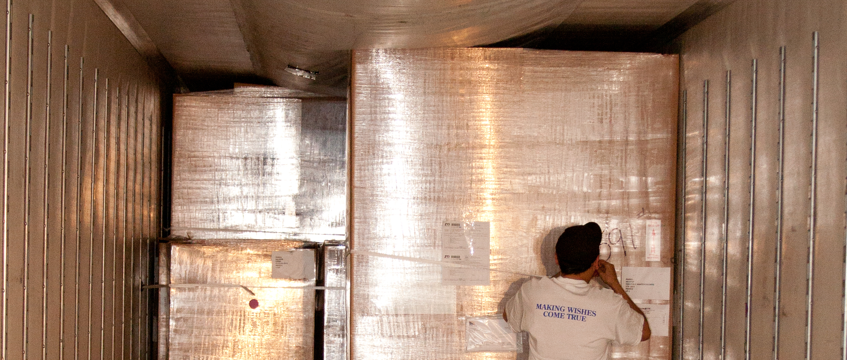Industry-wide Loading Inefficiencies Hurt Everyone; They Even Disrespect Our Drivers
Question: What do these industry players all have in common?
- The manufacturer that simply wants its product out the door and on its way, delivered on time and damage-free
- The shipping department manager whose sole focus is the cheapest carrier today, right now, on this immediate delivery
- The third-party logistics rep whose single-minded measure of success is moving the product down the road on the shipper’s timeline
Answer: With their narrowly focused, niche perspectives on the supply-chain process, they’re all part of a big problem.
They’re all contributing to huge inefficiencies that are costing “us” dearly … all of “us” in a North American economy that lives and dies by the truck.
We can resist operating in a vacuum, thinking that our individual actions as a shipper, carrier, logistics company, driver, or loading-crew member don’t impact each other.
Here’s how tricky it gets
Fingerpointing is a fairly unproductive behavior in business, and that’s why I say that we all share the blame for current problems.
Still, consider this: There are ingrained habits among 3PLs, brokers, and truck load carriers that are a disservice to shippers.
There is an absence of services available to the shipping public, to help them more efficiently and cost-effectively move their product. None of the carriers, including FedEx, UPS, and the rest, are filling the gap to serve shippers.
An example: You, as a shipper, have 20 feet of blanket-wrap product to move right now. Can you just pick up the phone and call any of these carriers to get some action? To get a quick and reasonable answer to delivery … without being transferred to their special commodity divisions? In almost every case, no you can’t! You’re transferred to special commodities, your shipment is then handled by their broker department or truck load division, which very well could result in a partial truck load.
Clearly, this is not just shippers saying they don’t care about the issue. We simply aren’t serving them with all the options they really need.
We’re Turning a Blind Eye
Here’s the biggest price we’re paying for perpetuating some really bad habits in the transportation industry: A generations-long driver shortage that we’ve inflicted upon ourselves.
I have many decades of working in trucking – too many to admit! – so allow me to make these rash statements based upon a life in the business. I promise to back them up with substantial, verifiable, research-based detail in future The Road Ahead blogs.
For the time being, though, here’s the bald pronouncement:
There would be no driver shortage on North American roads if we got serious about load efficiency and reforming the dysfunctional system that rewards bad practices at every step in the supply-chain process.
Thank goodness there are some improvements being made out there, such as paperwork reduction and navigation assistance to lessen daily stress on drivers in the field. A Telogis blog from last summer offers some good examples of the improvements. You can read that here.
Amazingly, though, a large part of the optimization puzzle is actually no-technology/low-technology. What it takes in particular are fully committed, well-trained people to shepherd the loading process, including these largely unsung heroes:
- factory floor pre-packaging crews
- loading dock and outbound handlers
- drivers – at every step in the process
- skilled, savvy optimizers at LTL, TL, 3PL sites
- dedicated delivery-site people who help with sometimes-complex delivery and unloading issues
The system is incomplete, broken
Even if everyone along the way is paying some attention to load efficiency and related supply-chain behaviors, the fact is that most of our North American markets for freight handling are missing entire cogs in the wheel of true optimization. The system is virtually abusing human capital in this equation by turning a blind eye on educating drivers, loading crews, and other important workers in the crazy patchwork quilt that is modern trucking.
Case in point: Manufacturer X contacts Logistics middleman Y and is assured that Product Z will arrive in a timely and damage-free manner to Customer A.
And the rate will be great, says Y.
Of course, X signs up with 3PL firm Y.
But hardly a word is spoken about optimizing every load, every day, at every distribution point in the process.
Don’t blame the shippers alone
Corporations today are constantly touting their sustainability. That’s great. And they’re doing an impressive job within their facilities and in working with their suppliers.
But they’re still washing their hands of the whole mess that happens once their product hits the back docks and rolls away from the factory.
I’m convinced that consumers would be outraged to learn that trucking systematically ignores the obvious efficiency of a truly “Full Truckload” and instead charges TL rates for any amateur loading job.
Again, it’s not really the shipper’s fault. Companies need to move their goods fast, and they feel like they just have to shut up and pay the price.
And guess what?
That’s how the average price of a new small car ends up being $25K, to $30k, or more. Consumers always pay for a system’s inefficiencies.
I mentioned that this situation disrespects the drivers, too.
When I used to “drive truck,” hauling a full trailer, well-loaded, from Manufacturer X to Customer A, it felt pretty good to be in the business. Attention to detail really seemed to matter.
Today, with a system that rewards speed alone – and cares very little about shippers overpaying for bad loading – I know that many drivers feel cynical about their long hauls of half-empty trailers.
Driver shortage? Sure. But our lack of intelligent solutions? Doubly sure.
I’m always open to your thoughts and comments.




